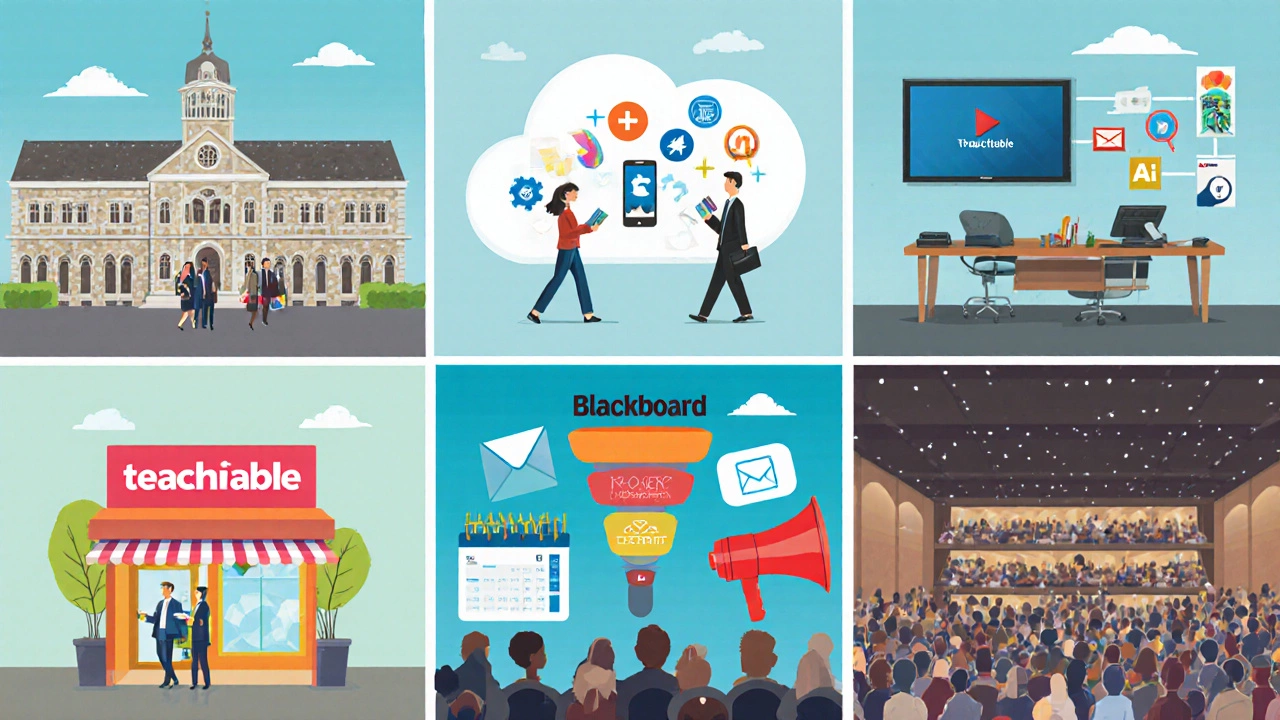
Trying to figure out which service actually qualifies as an eLearning platform can feel like hunting for a needle in a haystack. One moment you hear "Moodle is a learning management system," the next you see "Coursera offers online courses" and wonder - are they both eLearning platforms? This guide breaks down the core definition, walks through the most popular options, and gives you a practical checklist so you can pick the right tool for your teaching or training needs.
What actually counts as an eLearning platform?
eLearning platform is a digital environment that lets creators upload, organize, and deliver educational content while tracking learner progress. In practice, it bundles content hosting, assessment tools, user management, and reporting into a single web‑based service.
Key attributes include:
- Course creation tools (video, quizzes, assignments)
- Student enrollment and role management
- Progress tracking and analytics
- Scalable hosting (cloud or self‑hosted)
If a system provides most of these, it’s safe to call it an eLearning platform. Some services focus narrowly on one piece - like video hosting alone - and don’t meet the full criteria.
Learning Management System (LMS) vs. Marketplace vs. Course Builder
People often use "LMS" and "eLearning platform" interchangeably, but there’s a subtle difference. An Learning Management System (LMS) is a type of eLearning platform built for institutions, corporations, or training teams that need tight control over users and data. Marketplaces such as Udemy or Coursera host courses from many creators and take a revenue cut. Stand‑alone course builders like Teachable or Thinkific give individual instructors a storefront while handling most LMS features behind the scenes.

Top eLearning platforms you’ll encounter
- Moodle is an open‑source LMS used by universities and K‑12 schools worldwide. It offers deep customization via plugins, supports multi‑language interfaces, and can be self‑hosted for complete data control.
- Canvas is a cloud‑native LMS favored by higher education. Its clean UI, native mobile apps, and robust API make it easy to integrate with existing student information systems.
- Blackboard targets large universities and corporate training departments. It bundles virtual classroom tools, plagiarism detection, and analytics into a single suite.
- Teachable is a course‑builder platform that lets creators upload videos, set pricing, and sell directly to learners. It handles payment processing, customizable sales pages, and basic student tracking.
- Thinkific offers a similar storefront experience to Teachable but adds more advanced membership and drip‑content features, making it popular for subscription‑based programs.
- Kajabi blends eLearning with marketing automation. It’s a good fit for coaches and creators who need funnels, email sequences, and a built‑in membership site.
- Coursera operates as a marketplace that partners with universities to deliver MOOCs. While it hosts courses, it doesn’t give creators full LMS control; the platform dictates pricing models and certification processes.
- Udemy is another marketplace where anyone can publish a course. It’s great for reaching a massive audience, but revenue splits and limited branding can be a drawback for serious educators.
Side‑by‑side comparison
| Platform | Pricing (starting) | Self‑hosted? | Best for | Key strength |
|---|---|---|---|---|
| Moodle | Free (hosting costs vary) | Yes | Universities & schools | Deep customization via plugins |
| Canvas | $0 (institutional plans start at $2,500/yr) | No | Higher‑ed & large orgs | User‑friendly UI, strong API |
| Blackboard | From $9,000/yr | No | Enterprise training | All‑in‑one suite, analytics |
| Teachable | $39/mo | No | Individual creators | Easy storefront & payments |
| Thinkific | $49/mo | No | Membership & subscription courses | Advanced drip/content rules |
| Kajabi | $149/mo | No | Coaches & digital marketers | Integrated funnels & email |
| Coursera | Free to browse, $49‑$79 per course | No | MOOCs & university partners | Massive reach, accredited certs |
| Udemy | Free to publish, $19‑$199 per course | No | Broad audience, hobbyists | Huge marketplace traffic |
How to choose the right platform for your needs
Instead of scrolling endlessly through feature lists, ask yourself these three questions:
- Do I need full control over data and branding? If yes, look at self‑hosted LMSs like Moodle or a hosted enterprise plan.
- Am I selling courses directly to consumers or delivering training internally? Direct‑to‑consumer creators often gravitate toward Teachable, Thinkific, or Kajabi. Corporate trainers usually pick Canvas or Blackboard.
- What’s my budget for recurring fees and hosting? Open‑source solutions are cheap upfront but may need IT staff. SaaS platforms bundle support for a predictable monthly cost.
Match your answers to the comparison table above, then narrow down to two candidates. Most platforms offer a free trial - spend at least a week testing course upload, student enrollment, and reporting dashboards before committing.

Common pitfalls and how to avoid them
- Ignoring scalability. A platform that feels snappy with 10 users may choke at 500. Check whether the provider offers tiered plans or auto‑scaling.
- Overlooking integration needs. If you already use a CRM, webinar tool, or single sign‑on, verify the platform’s API or native connectors.
- Choosing a marketplace for brand building. Udemy and Coursera give you traffic, but you lose control over pricing and user data. Build a separate branded site if brand equity matters.
- Underestimating support. Open‑source LMSs are powerful, but you’ll need in‑house technical help or a paid support contract. Factor that into total cost.
Quick checklist before you sign up
- Does the platform support video, quizzes, and certificates?
- Is there a free trial or demo account?
- Can you export learner data at any time?
- Are payment gateways and tax handling built in?
- Does the UI feel intuitive for both you and your learners?
Frequently Asked Questions
Is a marketplace like Udemy considered an eLearning platform?
Yes, but only in a limited sense. Udemy provides the hosting, payment processing, and basic course tools, so it meets the core definition of an eLearning platform. However, it does not give you full control over branding, pricing, or learner data the way a dedicated LMS does.
Can I use a free, open‑source LMS for a commercial training business?
Absolutely. Platforms like Moodle are free to download and can be branded and monetized however you like. The catch is that you’ll need technical expertise to set up hosting, security, and regular updates.
What’s the biggest advantage of a SaaS LMS over a self‑hosted one?
SaaS solutions handle server maintenance, security patches, and backups automatically. That means you can focus on content creation instead of IT chores, and you typically get 99.9% uptime guarantees.
Do eLearning platforms support mobile learning?
Most modern platforms, including Canvas, Teachable, and Kajabi, offer responsive web design and dedicated iOS/Android apps. Mobile support is now a baseline expectation, not a premium feature.
How important is analytics in an eLearning platform?
Analytics let you see completion rates, quiz scores, and engagement trends. Without them you’re guessing whether your content works. Platforms like Blackboard and Canvas provide deep reporting, while course builders usually offer basic dashboards.
